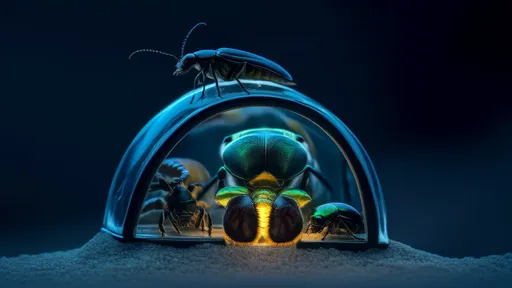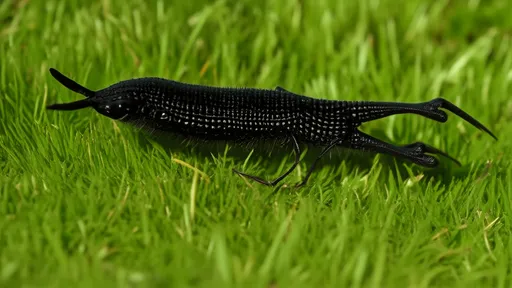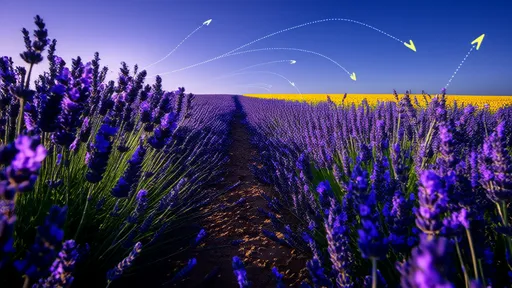In the heart of the desert, where the sun scorches the earth by day and the temperature plummets by night, an extraordinary world comes alive under the cover of darkness. The Desert Insect Hotel, a microcosm of survival and adaptation, plays host to a myriad of nocturnal creatures that defy the harsh conditions of their environment. These tiny architects of the night, often overlooked, are the unsung heroes of the desert ecosystem. Through the lens of a microscope, their intricate behaviors and physiological marvels are revealed in stunning detail.
The desert may seem barren to the untrained eye, but beneath the surface, it teems with life. The Desert Insect Hotel is not a physical structure but a metaphorical one—a concept that encapsulates the hidden niches and microhabitats where insects thrive. From the burrows of ants to the crevices of rocks, these "rooms" provide shelter from predators and the relentless climate. The residents of this hotel are as diverse as they are resilient, each species equipped with unique adaptations to survive the extremes of their environment.
One of the most fascinating inhabitants is the darkling beetle, a master of water conservation. Unlike other insects, the darkling beetle has evolved the ability to harvest moisture from the air. Its exoskeleton is covered with microscopic grooves that channel condensation directly to its mouth. This adaptation allows it to thrive where other creatures would perish from dehydration. Under the microscope, the beetle’s exoskeleton resembles a labyrinth of tiny canals, a testament to the ingenuity of evolution.
Another notable guest is the camel spider, often misunderstood and shrouded in myth. Despite its name, it is neither a true spider nor a scorpion but belongs to a unique order of arachnids. Camel spiders are voracious predators, capable of speeds that make them formidable hunters. Their jaws, when magnified, reveal serrated edges designed to tear through the exoskeletons of their prey. What’s more, their bodies are covered in sensory hairs that detect the slightest vibrations in the sand, allowing them to locate prey with uncanny precision.
The Desert Insect Hotel also shelters a variety of moths, whose nocturnal flights are a ballet of survival. Many desert moths have evolved scales that reflect the faint light of the moon, rendering them nearly invisible to predators. Under magnification, these scales appear like shingles on a roof, overlapping to create a surface that diffuses light. Some species even possess "ears" on their wings—specialized organs that detect the echolocation calls of bats, enabling them to execute evasive maneuvers mid-flight.
Ants, the architects of the underground, play a pivotal role in this ecosystem. Their colonies are sprawling networks of tunnels and chambers, some descending several meters below the surface. Microscopic examination of their mandibles reveals serrated edges capable of cutting through tough plant fibers and even the exoskeletons of rival insects. The honeypot ant, a peculiar resident, serves as a living pantry for its colony. Workers feed these ants until their abdomens swell with nectar, which they regurgitate during times of scarcity. Under the microscope, the translucent abdomen of a honeypot ant glows like a amber jewel, filled with the life-sustaining bounty of the desert.
The desert’s nocturnal symphony would be incomplete without the contribution of the Jerusalem cricket. Despite its name, this insect is neither a cricket nor native to Jerusalem. It is, however, a powerful digger, using its robust forelimbs to burrow into the earth. When viewed under magnification, its mandibles resemble miniature pliers, capable of crushing roots and decaying matter. These crickets are also known for their eerie, drumming sounds, produced by rubbing their abdomen against the ground—a form of communication that resonates through the silent desert night.
Perhaps the most enigmatic residents are the microscopic mites that inhabit the desert soil. These tiny arachnids, often less than a millimeter in length, are the unseen custodians of the ecosystem. They break down organic matter, recycling nutrients back into the soil. Under high magnification, their bodies are a patchwork of armored plates and delicate hairs, a combination that provides both protection and sensory perception. Some species have even formed symbiotic relationships with plants, living on their roots and aiding in water absorption.
The Desert Insect Hotel is a testament to the resilience and diversity of life in one of the planet’s most inhospitable environments. Each resident, from the towering camel spider to the minuscule mite, plays a vital role in maintaining the delicate balance of the desert ecosystem. Through the lens of a microscope, their hidden world is brought into sharp relief, revealing the extraordinary adaptations that allow them to thrive against all odds. These creatures are not merely survivors—they are the architects of their own destiny, carving out a existence in a land that challenges life at every turn.
As the night fades and the first light of dawn creeps across the dunes, the guests of the Desert Insect Hotel retreat to their hidden sanctuaries. The desert, once again, appears lifeless to the casual observer. But beneath the surface, the intricate web of life continues, waiting for the next nightfall to reveal its secrets once more.

By /Jul 16, 2025

By /Jul 16, 2025

By /Jul 16, 2025

By /Jul 16, 2025

By /Jul 16, 2025

By /Jul 16, 2025

By /Jul 16, 2025

By /Jul 16, 2025

By /Jul 16, 2025

By /Jul 16, 2025

By /Jul 16, 2025

By /Jul 16, 2025

By /Jul 16, 2025

By /Jul 16, 2025

By /Jul 16, 2025

By /Jul 16, 2025

By /Jul 16, 2025

By /Jul 16, 2025